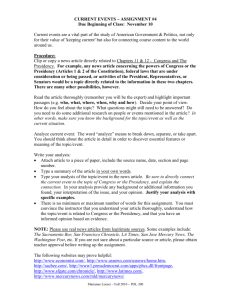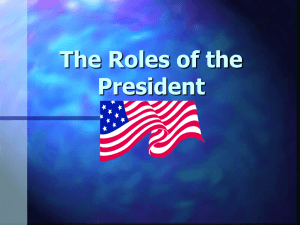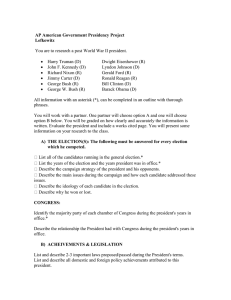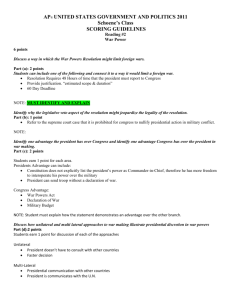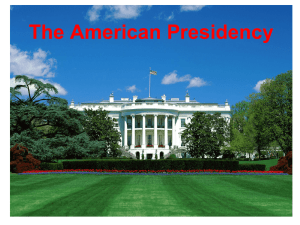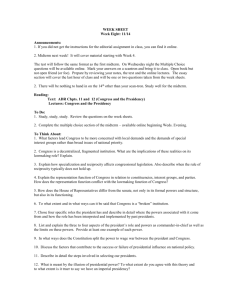Evolution of the Presidency powerpoint
advertisement
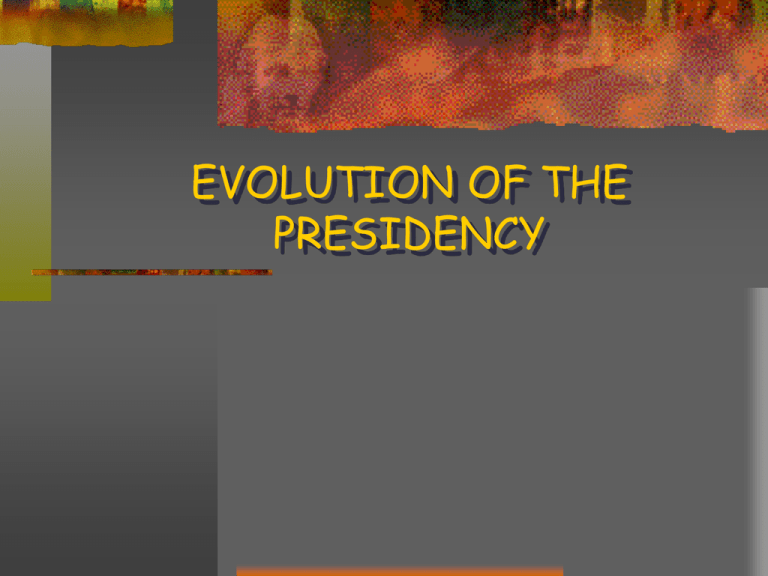
EVOLUTION OF THE PRESIDENCY Deliberations at the Constitutional Convention Alternatives. Some proposed a plural executive. Some wanted an executive council to have veto power over presidential actions. Some (e.g., Alexander Hamilton) wanted a President with a life term. Eventually, compromises brought about a single, elected President with a fixed term of office. Deliberations at the Constitutional Convention – con’t Concerns of the Founders. Fear of an excessively strong President. Fear that the presidency would be the "fetus of monarchy" (Edmund Randolph). Concern over no term limits (no 22nd Amendment until 1951). Fear of an excessively weak President who would become a "tool of the Senate“ because of its ratification and confirmation powers. The basic problem of creating a presidency was expressed by Gouverneur Morris: "Make him too weak: the legislature will usurp his powers. Make him too strong: he will usurp the legislature." Election of the President Some wanted Congress to elect the President—> fear of congressional dominance. Some wanted direct election. Problems: Inordinate weight to large states. Demagogues might have excessive appeal to the masses. Illiteracy was common. Communication was poor. Election of the President – The Compromise: The Electoral College The people had some input. Large states had a good amount of influence, but small states were protected by having a minimum of three electoral votes. Small states would also have a great deal of clout if the election were thrown into the House (and it was assumed that this would happen often since the two party system was not anticipated). Under this scenario, each state has one vote and small states are therefore grossly over-weighted. Term of office: Fear of an unlimited number of terms of office were quieted when Washington chose not to run for a third term. This precedent was followed until 1940. The first Presidents: Washington-Monroe, 1789-1825 All eminent men who were active in the movement for independence, all but Adams served two terms, all but Adams were Virginians. Though Washington warned against it, political parties developed. General "rule of fitness" prevailed in making appointments. Partisanship did become a factor, but generally only well-respected men received appointments. The presidency was kept modest. It was assumed that Congress would take the leading role in the new national government Andrew Jackson, 1829-1837, and the expansion of presidential power Use of spoils system. Jackson vetoed 12 acts of Congress, more than all his predecessors combined. Jackson ignored a Supreme Court order regarding Indian removal The reemergence of Congress, 1837-1932 With the end of Jackson's second term, Congress quickly reestablished its power. There were some brief flashes of presidential power, e.g., the wartime presidency of Lincoln (e.g., suspension of habeas corpus, blockading the South, raising an army, issuing the Emancipation Proclamation -- all without congressional consent), but Congress was the dominant branch. Of the next eight Presidents after Jackson, none served more than one term of office. The reemergence of Congress, 1837-1932 (con’t) With the exceptions of Theodore Roosevelt and Woodrow Wilson, the presidency was seen as a negative force - a source of opposition to Congress, not a source of initiative and leadership for it. This was best illustrated by Grover Cleveland's 414 vetoes, more than any President until FDR. Today, we are used to thinking that the President initiates legislative programs and Congress then responds; until the 1930's, however, the opposite was usually the case. In the past, it took either a strong personality (e.g., Jackson, TR, Wilson) or a crisis (e.g., Civil War, World War I) for the President to become the central figure of government. Emergence of the presidency Another crisis (the Great Depression) once again led to increased presidential power - FDR's New Deal. With the onset of World War II, a foreign policy crisis led to continued presidential power. The development of the Cold War facilitated continued presidential initiative and power: Truman, JFK, LBJ, Nixon. In the 1970's, Congress finally reasserted itself, but with mostly short-term results (as we shall see). Reagan restored the power and prestige of the presidency.
